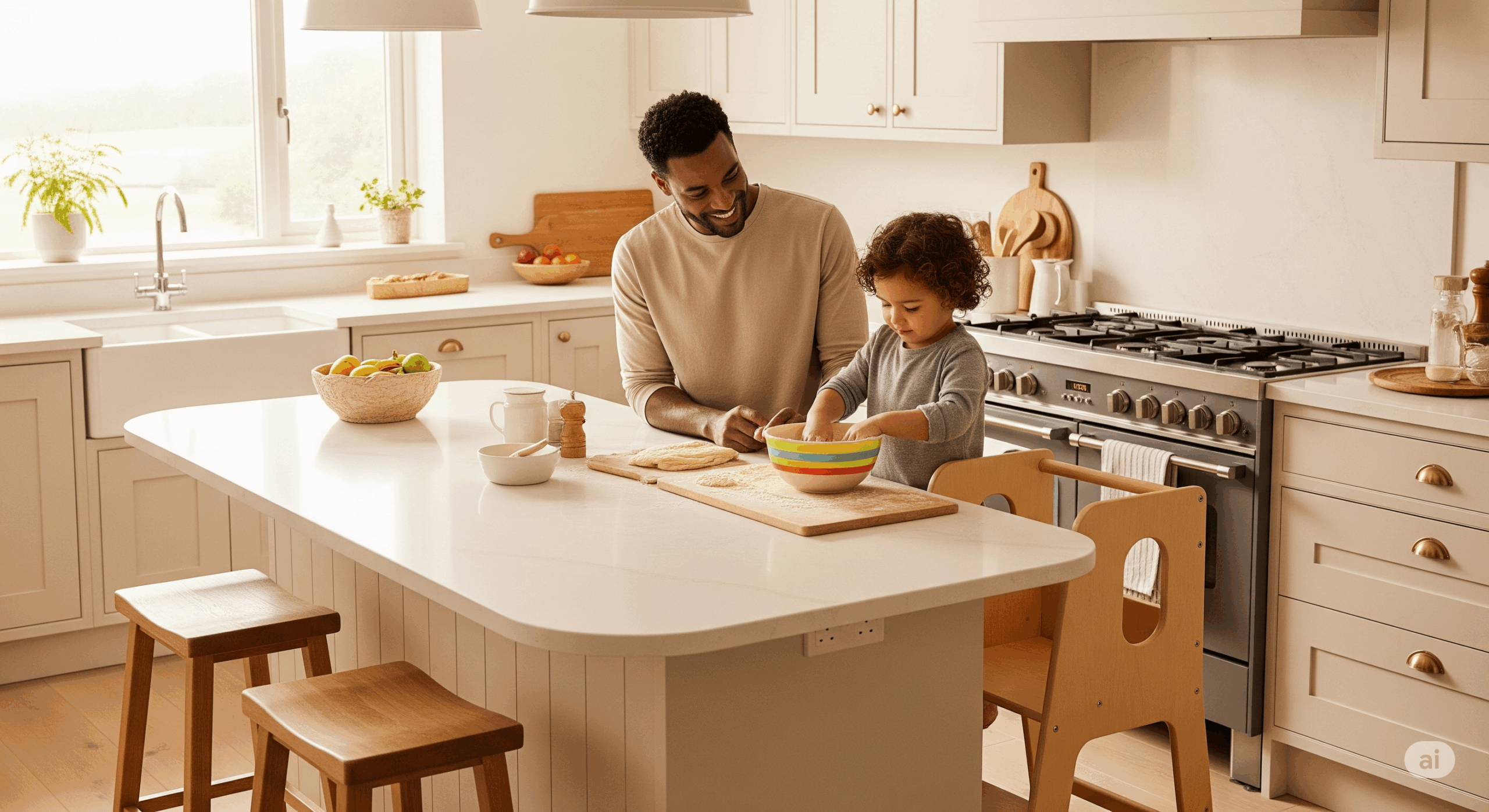The kitchen is the vibrant heart of family life, a place for more than just cooking. It’s where homework gets done, stories are shared, and little hands learn to help. Designing a kitchen that is truly family-friendly goes beyond just aesthetics; it involves creating a space that is safe for children, durable enough to withstand daily family chaos, and engaging enough to foster their involvement and independence. A well-designed child-friendly kitchen balances robust safety measures with features that make it a welcoming hub for every member of the family.
This guide explores practical design ideas and essential safety tips for creating a modern kitchen that the whole family can safely use and enjoy together.
1. Safety First: Essential Childproofing Measures
Safety is the non-negotiable foundation of a child-friendly kitchen.
- Secure Cabinets and Drawers: Install safety latches or magnetic locks on all lower cabinets and drawers that contain hazardous items, including cleaning supplies, sharp utensils, glassware, or heavy cookware.
- Appliance Safety:
- Ovens & Cooktops: Choose a range or wall oven with cool-touch doors and controls that are difficult for young children to reach or operate. An induction cooktop is an excellent choice as the surface itself does not get hot, significantly reducing burn risk.
- Refrigerators & Dishwashers: Use appliance locks if necessary to prevent children from opening them.
- Secure Furniture: Anchor any freestanding shelving units or tall furniture to the wall to prevent them from tipping over.
- Electrical Safety: Install tamper-resistant outlets or use outlet covers on all accessible electrical sockets to prevent shocks. Keep appliance cords tidy and out of reach.
- Gas Safety (LPG Cylinders): In households using LPG gas cylinders, common in regions like Indonesia, ensure the tank is in a secure, stable location, and consider keeping the area inaccessible to toddlers.
- Create a “No-Go Zone”: Visually define a “kid-free zone” around the primary cooking area (stove and oven) using a different colored floor mat or simply by teaching rules.
2. Design for Involvement & Independence
A truly child-friendly kitchen empowers kids to participate safely.
- Lowered Workstation or Pull-Out Step: Incorporate a small section of countertop at a lower height (around 28-30 inches) where children can comfortably help with simple, safe tasks like mixing or decorating. Alternatively, a sturdy pull-out step built into the base of a cabinet allows them to safely reach standard-height counters.
- Kitchen Helper Towers: These safe, enclosed step stools allow toddlers and young children to stand securely at counter height, fostering involvement in cooking activities.
- Accessible Storage for Kids: Designate a low drawer or cabinet specifically for children’s items. Stock it with their own kid-safe utensils, plates, cups, and healthy snacks so they can access them independently.
- Kid-Friendly Faucet: A single-lever faucet is easier for small hands to operate than separate knobs. A pull-down sprayer can also be fun and functional for helping with rinsing vegetables.
- Durable & Lightweight Dishware: Keep sturdy, non-breakable plates, bowls, and cups made from bamboo, melamine, or high-quality plastic in easily accessible drawers for children.
3. Durable & Easy-to-Clean Materials
Family kitchens need to be resilient. Choose materials that can handle spills, bumps, and constant cleaning.
- Countertops:
- Quartz: A top choice for its extreme durability, non-porous nature (resisting stains from juice, markers, etc.), and ease of cleaning.
- Laminate: A highly budget-friendly option with modern finishes that is easy to wipe clean, though it is less resistant to heat and deep scratches.
- Solid Surface: Non-porous and seamless, and minor scratches can often be buffed out.
- Edge Profile: Opt for rounded countertop edges (like a bullnose or half-bullnose) to prevent injuries from sharp corners.
- Cabinet Finishes:
- Laminate or Thermofoil: These durable finishes are easy to wipe clean and are resistant to chipping.
- Durable Paint: If using painted cabinets, choose a high-quality, scrubbable semi-gloss or satin paint that can withstand frequent wiping. Matte finishes may show fingerprints and smudges more easily.
- Flooring:
- Luxury Vinyl Tile (LVT/LVP): An excellent choice. It’s highly durable, waterproof, scratch-resistant, softer underfoot than tile (cushioning falls), and easy to clean.
- Linoleum/Marmoleum: Natural, durable, and relatively soft.
- Avoid: Highly polished, slippery tiles. If using tile, choose a matte or textured finish with a good slip-resistance rating.
- Backsplash:
- Easy-to-Clean Surfaces: Choose materials like large-format tiles (fewer grout lines), back-painted glass, or a slab backsplash for easy wipe-downs.
4. Smart Layout Considerations
A safe layout minimizes accidents and maximizes family interaction.
- Island Design: If you have a kitchen island, try to keep the cooktop off the island if possible, creating a safer “no-heat” zone for kids to sit and do homework. Rounded island corners are essential.
- Traffic Flow: Design for wide, clear pathways to prevent trips and collisions, especially when someone is carrying something hot.
- Appliance Placement: Place the refrigerator in a location accessible to the family without requiring them to walk through the primary cooking zone. A microwave placed at or below counter height is safer and more accessible for older children.
Conclusion
Creating a child-friendly modern kitchen is a thoughtful investment in your family’s safety, happiness, and development. It’s about designing a space where kids are protected from hazards, but also feel welcomed and empowered to learn and participate. By prioritizing robust safety features, choosing durable and easy-to-clean materials, and incorporating smart, accessible design elements, you can build a beautiful modern kitchen that truly serves as the functional and joyful heart of your family home for years to come.







Leave a Comment